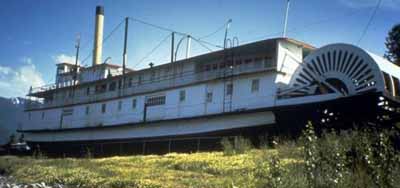S.S. Moyie National Historic Site of Canada
Kaslo, British Columbia

General view
(© Parks Canada Agency / Agence Parcs Canada.)
Address :
Kaslo, British Columbia
Recognition Statute:
Historic Sites and Monuments Act (R.S.C., 1985, c. H-4)
Designation Date:
1958-11-03
Dates:
-
1898 to 1898
(Construction)
-
1898 to 1958
(Significant)
Event, Person, Organization:
-
British Columbia Lake and River Service, Canadian Pacific Railway
(Organization)
-
Bertram Engine Works
(Builder)
-
British Columbia Lake and River Service, Canadian Pacific Railway, Nelson
(Builder)
Other Name(s):
-
S.S. Moyie
(Designation Name)
Research Report Number:
1957, 1982-013
Plaque(s)
Existing plaque: Kaslo, British Columbia
This elegant sternwheeler is the oldest intact passenger steam vessel of its type in the world. The machinery and the steel frames of its hull were built by the Bertram Engine Works of Toronto, shipped west by rail and assembled in Vancouver. Launched at Nelson on 22 October 1898 by the Canadian Pacific Railway, the S. S. Moyie carried passengers and freight on Kootenay Lake for 59 years. It was retired from service in 1957. Rescued and preserved by the people of Kaslo, the "sweetheart of the lake" recalls the role of sternwheelers in the history of western Canada.
Description of Historic Place
The S.S. Moyie National Historic Site of Canada is a late 19th-century, steam-propelled, stern-wheeler, located on the south shore of Kaslo Bay on Kootenay Lake. She has been in dry dock since 1958. Official recognition refers to the vessel itself.
Heritage Value
The S.S. Moyie was designated a national historic site of Canada in 1958 and reaffirmed in 1983, because: upon retirement she was the oldest Canadian-built paddle wheeler in service; of the significant role played by such vessels in the opening up and development of the interior of British Columbia;
The heritage value of this site resides in its historical associations and in the physical properties of the vessel itself.
The S. S. Moyie was built and assembled in 1898 at the Canadian Pacific Railway shipyard at Nelson, British Columbia. She is typical in most respects of steam-powered vessels on western and northern inland waters but is distinguished from other steamers by the composite construction of her hull, comprised of steel frame with wooden planking. Her steel frame and propulsion machinery were supplied by Bertram Engine Works of Toronto.
The S. S. Moyie was built to provide marine service across Kootenay Lake from Nelson to Kootenay Landing, thereby connecting the Crowsnest Pass Railway with the Canadian Pacific lines to the west. Her interior arrangements suit this use, with plenty of dining room and lounge space, and sleeping cabins. Operated by the Canadian Pacific Railway’s British Columbia Lake and River Service, the S.S. Moyie provided various services on Kootenay Lake from her launch in 1898 until her retirement in 1957.
Sources: Historic Sites and Monuments Board of Canada, Minutes, November 1958, November 1983; Commemorative Integrity Statement, 2000.
Character-Defining Elements
Key elements that define the heritage value of this site include: her location next to Kootenay Lake; her original massing, scale and proportions, surface material, colour, hull configuration, and interior and exterior elements; surviving working-life components of the vessel’s fabric, including the hull, superstructure, propulsion and auxiliary systems, external components such as smoke stack, paddle wheel, hog posts and chains, capstan, interior layout, and fittings; features typical of steam-powered lake vessels, including a shallow-draft, wood-sheathed hull, a lightly built superstructure, and a single, stern-mounted paddle wheel; her single, stern-mounted paddle wheel, 5.9 metres in diameter, with 17 buckets; her hull length of 49.4 metres with a beam of slightly more than 9.2 metres; her four rudders; her composite hull construction, consisting of steel frames to which wood planking is bolted; the propulsion machinery, including the locomotive-type boiler and 2 single-piston high-pressure horizontal engines.